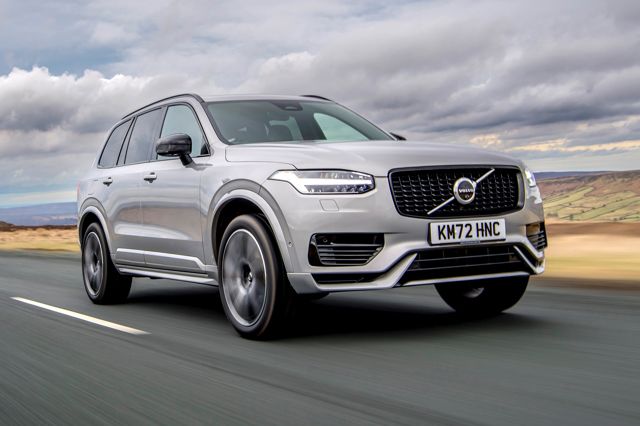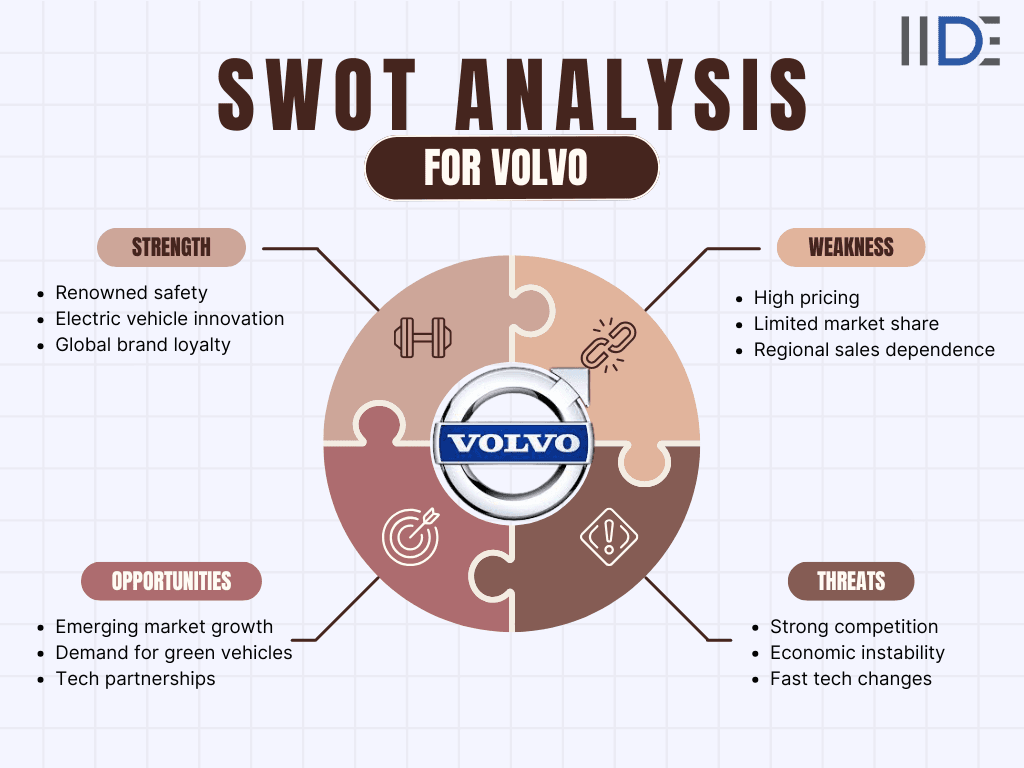Decode how AI is reshaping careers in 2026 with our Head of AI Programs in a LIVE online session. Register Now.

Updated on Oct 15, 2025
Share on:
Is Volvo still the safest and most dependable brand in 2025? With the automotive industry undergoing swift electrification, increasing competition, and fluctuating consumer demands, analysing Volvo’s strategic position has never been more significant.
In this article, we will present an updated SWOT Analysis of Volvo in the year 2025, breaking down the company’s strengths, weaknesses, opportunities, and threats with the current market data. This will help us understand how Volvo is navigating global challenges while staying true to its principal values of safety, sustainability, and innovation.
Before diving into the analysis, I would like to inform you that the research and initial analysis for this piece were conducted by Saharsh Vardhan. He is a current student in IIDE's PG in Digital Marketing, March Batch 2025.
About Volvo: How Safety, Sustainability, and Scandinavian Design Define Its Legacy
Founded in Gothenburg, Sweden, in 1927, Volvo has built its legacy on safety, durability, and Scandinavian design. Its name, derived from the Latin “volvere” meaning “I roll,” along with the iconic Iron Mark logo, symbolise strength and resilience.
Over the years, Volvo has introduced groundbreaking innovations such as the three-point seatbelt and advanced driver assistance systems, reinforcing its reputation as a safety pioneer. The brand’s top-selling model, the XC60, has achieved remarkable success with more than 2.7 million units sold globally since 2008.

Volvo’s commitment to sustainability is reflected in its ambitious vision to ensure that 50% of its sales will be electric by 2025 and 100% all-electric by 2030.
A significant global milestone was also reached in 2025 when Volvo surpassed 5 million cars sold in the United States. Embodying its philosophy of building vehicles that protect people and stand the test of time, the brand’s enduring slogan, “Volvo for life”, perfectly captures its mission.


Learn Digital Marketing for FREE


SWOT Analysis of Volvo in 2025: Navigating Disruption, Driving Sustainability
In a year defined by rapid electrification, shifting consumer expectations, and financial headwinds, SWOT analysis provides Volvo with the clarity to protect its legacy and power its future.
1. Strategic Decision-Making: Leveraging SWOT for Smarter Choices
A structured SWOT analysis helps Volvo make informed decisions by showcasing strengths like R&D and sustainability, while highlighting risks such as shrinking margins and EV competition.
2. Responding to Industry Transformation: Electrification, Regulation, and Consumer Shifts
With stricter emission laws, rising EV adoption, and changing consumer preferences, Volvo uses SWOT insights to track electrification progress, mitigate supply chain risks, and adapt strategies in markets like the U.S. and China.
3. Enhancing Resilience: Aligning Costs, Cash, and Innovation
Amid pricing pressures and declining profitability, SWOT ensures Volvo’s cost control, restructuring, and product innovation remain aligned with external threats and opportunities.
4. Sustaining Competitive Advantage: Driving Growth through EVs and Digitalisation
To maintain its edge, Volvo must expand its EV lineup, strengthen its sustainability commitments, and leverage digital transformation to defend its profitability and brand identity.
SWOT Analysis of Volvo
Volvo remains a global leader in safety and sustainability, but faces major hurdles in electrification, profitability, and market dependence. Its diversified portfolio, innovation pipeline, and sustainability-first approach provide stability, while execution risks and intensifying EV competition threaten growth.
Strengths of Volvo: Why the Scandinavian Icon Still Sets the Standard
Volvo has successfully built its reputation as one of the safest, most sustainable, and reliable automotive brands globally. Its diversified business portfolio, strong R&D investments, and Scandinavian design principles ensure that Volvo continues to stand out in a competitive automotive landscape in 2025.
1. Diversified Portfolio
- Operates across cars, trucks, buses, construction equipment, and financial services.
- Revenue diversification helps offset risks from downturns in any one market.
- Stability in trucks and construction equipment provides consistent cash flow.
2. Market Leadership
- Volvo Trucks holds over 20% global market share, dominating the heavy-duty segment.
- Known worldwide for reliability, safety, and premium positioning.
- Trusted partner for logistics and infrastructure industries.
3. Research & Development (R&D)
- Pioneered safety features like the three-point seatbelt and advanced driver assistance.
- Consistently achieves top ratings such as NHTSA 5-star safety scores.
- Major investments in electrification and software-defined vehicles keep Volvo competitive against Tesla and Chinese EV startups.
4. Global Presence & Reputation
- Operations in over 100 countries, with strong market positions in Europe, U.S., and China.
- Recognized as one of the world’s most sustainable automakers.
- Scandinavian design heritage adds to brand distinctiveness.
5. Commitment to Sustainability
- Plans for 50% of sales to be electric by 2025, reaching 100% by 2030.
- Early mover advantage in meeting global EV regulations.
- Builds brand equity with eco-conscious consumers.
Weaknesses of Volvo: The Challenges of Electrification and Dependability
While Volvo’s reputation for safety and sustainability is strong, the brand faces financial, operational, and market challenges in its electrification journey. Rising costs and regional dependence pose risks to its growth strategy.
1. Product Recalls
- Recent recalls over structural flaws and panel defects have hurt consumer confidence.
- Quality control issues challenge Volvo’s “dependability” positioning.
- Increased recalls risk damaging its long-standing safety image.
2. Declining Profit Margins
- Rising EV R&D and production costs cut into profitability.
- Price competition in China further reduces margins.
- Shareholders are increasingly concerned about long-term financial stability.
3. Production & Supply Chain Challenges
- EV production faces shortages of semiconductors and battery raw materials.
- Delays in China and U.S. disrupted sales performance in 2025.
- Supply chain volatility makes it harder to meet electrification targets.
4. High Market Dependence
- Heavy reliance on China and the U.S. exposes Volvo to regional downturns.
- In Q1 2025, China sales dropped 12%, revealing vulnerability.
- Limited geographic diversification compared to some competitors.
Opportunities of Volvo: Driving Growth Through Electrification and Sustainability
Volvo is well-positioned to leverage global EV adoption trends, luxury consumer demand, and digital transformation. With a strong innovation pipeline, the company can strengthen its premium brand identity in 2025 and beyond.
1. Electrification & Sustainability Push
- Rapid global EV adoption aligns with Volvo’s 100% electrification roadmap.
- Strong consumer appeal in eco-conscious markets like Europe.
- Volvo’s green positioning differentiates it from mass-market automakers.
2. Product Portfolio Expansion
- Plans to launch five new models in 2025, including the EX60 midsize BEV and ES90 luxury sedan.
- Expands its presence in both the premium SUV and luxury EV categories.
- Strengthens positioning against Tesla, BMW i-series, and Mercedes EQ.
3. Premium Market Growth
- Luxury EV market expected to grow at 20% CAGR by 2030.
- Volvo’s sustainability-driven image resonates with high-end buyers.
- Brand equity helps capture a larger share of the premium EV segment.
4. Digital Transformation
- Focus on connected services, apps, and subscription models.
- Over-the-air updates improve customer experience and retention.
- Data-driven engagement offers new revenue opportunities.
Threats to Volvo: Rising Competition and the Risks of Rapid Electrification
Despite strong positioning, Volvo faces risks from intensifying competition, regulatory volatility, and execution challenges in its electrification strategy.
1. Intense Competition
- Competes against Tesla, Mercedes, GM, Tata, Kia, and Chinese EV startups like BYD and Nio.
- Competitors are moving faster with price cuts and technology adoption.
- Market crowding could dilute Volvo’s premium positioning.
2. Geopolitical & Regulatory Risks
- EV subsidies being reduced in China and Europe threaten growth.
- Trade tariffs increase operational costs in key regions.
- Sudden regulation changes create uncertainty in pricing and sales.
3. Macroeconomic Headwinds
- Global inflation and forex volatility reduce profitability.
- Auto demand slowing down in key economies during 2025.
- High interest rates reduce consumer affordability of premium EVs.
4. Transition Complexities
- Moving from combustion engines to EVs requires massive investment.
- Execution missteps could delay roadmap and frustrate customers.
- Costs of restructuring weigh heavily on financial performance.
Curious to explore more insightful analyses? Dive into the SWOT Analysis of Maruti Suzuki for a deeper look at how another industry leader navigates its strengths, weaknesses, opportunities, and threats.

IIDE Student Takeaway, Recommendations & Conclusion
From Volvo’s journey in 2025, students and marketers can draw several lessons:
- Diversification across segments such as trucks, buses, construction equipment, and financial services highlights the importance of building a balanced portfolio to reduce market risk.
- Volvo’s consistent leadership in safety and its heavy R&D investment showcase how innovation can transform into a long-term competitive edge.
- At the same time, challenges like recurring recalls, strained supply chains, and shrinking profit margins reveal how even strong brands must remain vigilant in operations and execution.
- The company’s sustainability-first approach, with ambitious EV targets and hybrid transitions, underlines how aligning with regulatory shifts and consumer values is now a survival strategy, not a choice.
- Finally, Volvo’s focus on digital transformation emphasizes that in today’s era, even legacy brands must adapt quickly to connected services, online experiences, and data-driven marketing in order to remain relevant in increasingly digital-first markets.
Volvo’s SWOT analysis in 2025 reveals a brand that continues to command global respect but faces mounting pressures in its transition to an electric and digital future. Its reputation for safety, innovation, and Scandinavian design still sets it apart, but operational risks, declining margins, and intensified EV competition create significant hurdles.
Core Tension: While Volvo’s heritage and global presence provide stability, the execution risks of electrification and its heavy reliance on a few key markets leave the brand vulnerable during a critical industry shift.
Future Outlook: To maintain competitiveness, Volvo must balance its sustainability ambitions with operational discipline, ensuring profitability while delivering on its promise of fully electric mobility. Expanding beyond its reliance on China and the U.S., and doubling down on digital ecosystems and premium EV experiences, will be central to sustaining growth.
Recommendations:
- Quality & Reliability: Strengthen product testing and after-sales support to reduce recalls and protect brand trust.
- Profitability & Efficiency: Reassess R&D spend and streamline supply chains to manage costs while driving innovation.
- Geographic Diversification: Expand presence in emerging markets to mitigate overdependence on the U.S. and China.
- Digital Expansion: Invest in connected car services, customer apps, and data-driven engagement to deepen loyalty.
- Premium EV Positioning: Differentiate Volvo’s electric lineup through its safety-first, sustainability-driven identity to capture the luxury EV segment.
Volvo’s strong innovation pipeline, sustainability commitments, and brand equity position it to remain a key player in the evolving automotive landscape. However, its ability to thrive will depend on how effectively it manages the transition from internal combustion engines to software-defined, fully electric vehicles.
Looking ahead, if Volvo can execute on its electrification roadmap, expand into new markets, and strengthen its digital-first engagement, it has the potential to stand alongside Tesla, Mercedes, and BMW as a leader in the global premium EV space.
By embracing its safety heritage while adapting to sustainability and digital transformation, Volvo can remain not only a trusted brand of the past but also a competitive force for the future.
Want to Know Why 2,50,000+ Students Trust Us?
Dive into the numbers that make us the #1 choice for career success

MBA - Level
Best For
Fresh Graduates
Mode of Learning
On Campus (Mumbai & Delhi)
Starts from
Jan 5, 2026
Duration
11 Months
Live & Online
Best For
Working Professionals
Mode of Learning
Online
Starts from
Dec 19, 2025
Duration
4-6 Months

Online
Best For
AI Enthusiasts
Mode of Learning
Online
Duration
5 Months

Offline
Best For
12th Passouts
Mode of Learning
On Campus (Mumbai)
Duration
3 Years
Recent Post
Aditya Shastri leads the Business Development segment at IIDE and is a seasoned Content Marketing expert. With over a decade of experience, Aditya has trained more than 20,000 students and professionals in digital marketing, collaborating with prestigious institutions and corporations such as Jet Airways, Godrej Professionals, Pfizer, Mahindra Group, Publicis Worldwide, and many others. His ability to simplify complex marketing concepts, combined with his engaging teaching style, has earned him widespread admiration from students and professionals alike.
Aditya has spearheaded IIDE’s B2B growth, forging partnerships with over 40 higher education institutions across India to upskill students in digital marketing and business skills. As a visiting faculty member at top institutions like IIT Bhilai, Mithibai College, Amity University, and SRCC, he continues to influence the next generation of marketers.
Apart from his marketing expertise, Aditya is also a spiritual speaker, often traveling internationally to share insights on spirituality. His unique blend of digital marketing proficiency and spiritual wisdom makes him a highly respected figure in both fields.